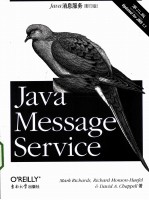图书介绍
Java消息服务 影印版2025|PDF|Epub|mobi|kindle电子书版本百度云盘下载

- MarkRichards,RichardMonson-Haefel著 著
- 出版社: 南京:东南大学出版社
- ISBN:9787564119300
- 出版时间:2010
- 标注页数:307页
- 文件大小:25MB
- 文件页数:327页
- 主题词:JAVA语言-程序设计-英文
PDF下载
下载说明
Java消息服务 影印版PDF格式电子书版下载
下载的文件为RAR压缩包。需要使用解压软件进行解压得到PDF格式图书。建议使用BT下载工具Free Download Manager进行下载,简称FDM(免费,没有广告,支持多平台)。本站资源全部打包为BT种子。所以需要使用专业的BT下载软件进行下载。如BitComet qBittorrent uTorrent等BT下载工具。迅雷目前由于本站不是热门资源。不推荐使用!后期资源热门了。安装了迅雷也可以迅雷进行下载!
(文件页数 要大于 标注页数,上中下等多册电子书除外)
注意:本站所有压缩包均有解压码: 点击下载压缩包解压工具
图书目录
1.Messaging Basics1
The Advantages of Messaging3
Heterogeneous Integration3
Reduce System Bottlenecks3
Increase Scalability4
Increase End User Productivity4
Architecture Flexibility and Agility5
Enterprise Messaging5
Centralized Architectures7
Decentralized Architectures7
Hybrid Architectures8
Centralized Architecture As a Model8
Messaging Models9
Point-to-Point10
Publish-and-Subscribe10
JMS API11
Point-to-Point API13
Publish-and-Subscribe API14
Real-World Scenarios14
Service-Oriented Architecture15
Event-Driven Architecture16
Heterogeneous Platform Integration16
Enterprise Application Integration17
Business-to-Business17
Geographic Dispersion18
Information Broadcasting18
Building Dynamic Systems18
RPC Versus Asynchronous Messaging21
Tightly Coupled RPC21
Enterprise Messaging23
2.Developing a Simple Example25
The Chat Application25
Getting Started with the Chat Example28
Examining the Source Code30
Sessions and Threading39
3.Anatomy of a JMS Message41
Headers42
Automatically Assigned Headers43
Developer-Assigned Headers46
Properties47
Application-Specific Properties47
JMS-Defined Properties49
Provider-Specific Properties50
Message Types50
Message50
TextMessage51
ObjectMessage52
BytesMessage53
StreamMessage56
MapMessage58
Read-Only Messages60
Client-Acknowledged Messages61
Interoperability and Portability of Messages61
4.Point-to-Point Messaging63
Point-to-Point Overview63
When to Use Point-to-Point Messaging66
The QBorrower and QLender Application67
Configuring and Running the Application67
The QBorrower Class69
The QLender Class76
Message Correlation81
Dynamic Versus Administered Queues83
Load Balancing Using Multiple Receivers84
Examining a Queue85
5.Publish-and-Subscribe Messaging87
Publish-and-Subscribe Overview87
When to Use Publish-and-Subscribe Messaging89
The TBorrower and TLender Application90
Configuring and Running the Application90
The TLender Class92
The TBorrower Class96
Durable Versus Nondurable Subscribers100
Dynamic Versus Administered Subscribers101
Unsubscribing Dynamic Durable Subscribers104
Temporary Topics104
6.Message Filtering107
Message Selectors109
Identifiers110
Literals111
Comparison Operators111
Arithmetic Operators113
Declaring a Message Selector114
Message Selector Examples116
Managing Claims in an HMO116
Notification of Certain Bids on Inventory116
Priority Handling116
Stock Trade Order Auditing117
Not Delivered Semantics117
Design Considerations118
7.Guaranteed Messaging and Transactions125
Guaranteed Messaging125
Message Autonomy126
Store-and-Forward Messaging126
Message Acknowledgments and Failure Conditions126
Message Acknowledgments127
AUTO_ACKNOWLEDGE127
DUPS_OK_ACKNOWLEDGE132
CLIENT_ACKNOWLEDGE132
Message Groups and Acknowledgment133
Handling Redelivery of Messages in an Application134
Message Groups Example134
Message Grouping and Multiple Receivers143
Transacted Messages145
Creating and Using a JMS Transaction147
Transacted Session Example147
Distributed Transactions150
Lost Connections151
The ExceptionListener Example152
Dead Message Queues153
8.Java EE and Message-Driven Beans155
Java EE Overview155
Enterprise JavaBeans156
Enterprise JavaBeans 3.0(EJB3)Overview157
Simplified Bean Development158
Dependency Injection158
Simplified Callback Methods159
Programmatic Defaults159
Interceptors160
Java Persistence API162
JMS Resources in Java EE162
The JNDI Environment Naming Context(ENC)164
Message-Driven Beans166
Concurrent Processing and Scalability168
Defining Message-Driven Beans168
Message-Driven Bean Use Cases171
Message Facade171
Transformation and Routing173
9.Spring and JMS177
Spring Messaging Architecture177
JmsTemplate Overview180
Send Methods181
convertAndSend Methods181
receive and receiveSelected Methods182
receiveAndConvert Methods183
Connection Factories and JMS Destinations184
Using JNDI184
Using Native Classes187
Sending Messages189
Using the send Method190
Using the convertAndSend Method191
Using a Nondefault JMS Destination193
Receiving Messages Synchronously195
Message-Driven POJOs198
The Spring Message Listener Container198
MDP Option 1:Using the MessageListener Interface199
MDP Option 2:Using the SessionAwareMessageListener Interface201
MDP Option 3:Using the MessageListenerAdapter202
Message Conversion Limitations207
The Spring JMS Namespace208
<jms:listener-container>Element Properties209
<jms:listener>Element Properties211
10.Deployment Considerations213
Performance,Scalability,and Reliability213
Determining Message Throughput Requirements213
Testing the Real-World Scenario214
To Multicast or Not to Multicast217
TCP/IP218
UDP218
IP Multicast218
Messaging Over IP Multicast219
The Bottom Line221
Security222
Authentication222
Authorization223
Secure Communication224
Firewalls and HTTP Tunneling224
Connecting to the Outside World225
Bridging to Other Messaging Systems227
11.Messaging Design Considerations229
Internal Versus External Destination229
Internal Destination Topology230
External Destination Topology231
Request/Reply Messaging Design232
Messaging Design Anti-Patterns236
Single-Purpose Queue236
Message Priority Overuse240
Message Header Misuse240
A.The Java Message Service API245
B.Message Headers265
C.Message Properties277
D.Installing and Configuring ActiveMQ285
Index291
热门推荐
- 1212511.html
- 1621163.html
- 1858570.html
- 3850251.html
- 1739587.html
- 1182522.html
- 2725746.html
- 3405383.html
- 1837816.html
- 917183.html
- http://www.ickdjs.cc/book_804949.html
- http://www.ickdjs.cc/book_1539683.html
- http://www.ickdjs.cc/book_2536239.html
- http://www.ickdjs.cc/book_1747599.html
- http://www.ickdjs.cc/book_243528.html
- http://www.ickdjs.cc/book_899002.html
- http://www.ickdjs.cc/book_3343377.html
- http://www.ickdjs.cc/book_3505991.html
- http://www.ickdjs.cc/book_877000.html
- http://www.ickdjs.cc/book_2458827.html